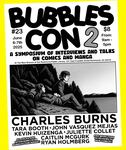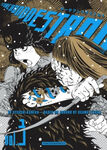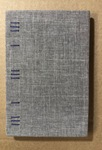
We've been selling Starstruck in one form or another since 1980, but were so used to hand-selling it that it didn't occur to us to put it onto our site... until now!
A long-time Copacetic favorite (that was, before that, a BEM favorite), Starstruck is the comics space opera par excellence! Lee and Kaluta's wacky, hi-jinx, freewheeling approach to story and relative unconcern with narrative cohesion (riffing, to some degree, on Gravity's Rainbow by Thomas Pynchon) – along with its non-linear approach to time – it has been printed in multiple arrangements and different orders without deleterious effect – allowed a truly epic scope for imaginative possibilities that resulted, in turn, in providing a muti-point perspective on the intertwinings of business and politics and sex and romance and war along the long arc of life from childhood to adolescence through adulthood to senescence – plus cloning – and more! FAR ahead of its time (for comics), not least in its dominating women and female-driven storylines, Starstruck began life in 1979/80 as an off-off-Broadway play by Lee, for which Kaluta designed characters, costumes (and sets?) which ran briefly on the stage and also resulted in the 1980 publication of Kaluta's Starstruck Portfolio which was largely sold into the comic cook direct market. After the run's conclusion, Lee and Kaluta decided to continue it... in comics! Its comics life began in 1982, by being serialized in Heavy Metal magazine, going on to be collected as one of the first Marvel Graphic Novels in 1984, and then continuing as one of the first creator-owned Epic series, which ran six issues through 1985. There were then some Galactic Girl Guides (part of the Starstruck multiverse) short stories that were published as back-ups in Dave Stevens's Rocketeer in the late '80s. A few years passed, and then in the early '90s Lee and Kaluta expanded what had been done before, but instead of simply writing new stories and tacking them on what had come before, they took the unusual decision to weave the new work thorugh the old work! This was enabled by the freewheeling modus operandi. Then followed a long hiatus... before it was finally (mostly) collected, in 2010, into the volume we have before us here, with all new lush coloring by Lee Moyer. Along with yet another configuration of the comics, we get all the Galactic Girl Guides stories, and addenda galore! An appendix/glossary/encyclopedia of the Starstruck multiverse, "Ordering Anarchera" along with activities, ship designs, a history of the project (which goes over in more detail what we are covering here), photographs (that we believe are) from the original stage production, all sorts of miscellanea and plenty of great Kaluta art!
Starstruck is a rich, multi-layered work that rewards – and, yes, demands – multiple readings. It is filled with unexpected observations and insights all vividly rendered by Kaluta in what has to be considered his best work. A member of the legendary late-seventies group of comics artists that also included Barry Windsor-Smith, Jeffrey (later Catherine) Jones, and Berni Wrightson, known as The Studio, who together worked to raise the artistry of comics to new levels, bringing styles and techniques derived from fin de siecle European painting, illustration and print-making, along with elements taken from American classic children's book and magazine illustration. Heady days! Starstruck is, in the Copacetic view – the most substantial and successful single comics work to come out of that ferment.
And, just FYI, it doesn't end here. In 2017, the remaining, uncollected earlier work was, once again, expanded through an interweaving of all new material in Starstruck: Old Proldiers Never Die (which we will list shortly).
HIGHLY RECOMMEDED!

There are tons of rarely seen – along with some very rarely seen – horror comics from the late 1960s filling this nicely produced hardcover volume. Web of Horror magazine is most notable – at least to us here at Copacetic – for providing an outlet for the early work of Bernie Wrightson, Michael Kaluta, Jeff Jones, Bruce Jones, and Frank Brunner, who together embodied a then-new school of comics that harkened back to the glory days of high quality illustration.
Here's what Fanta has to say:
The legendary, creator-controlled horror magazine from 1969 collected at last!In 1969, a feisty new comics magazine emerged to rival the popular horror magazines Creepy and Eerie: Web of Horror. Conceived by a plucky, independent publisher, Web of Horror showcased instant classics of horror and science fiction by such rising stars of comic art as Bernie Wrightson, Michael Kaluta, Bruce Jones, Ralph Reese, Frank Brunner, Roger Brand, and Wayne Howard, as well as seasoned veterans such as Syd Shores and Norman Nodel, illustrating stories written by Otto Binder, Nicola Cuti, and others.
Now, over 50 years later, Fantagraphics presents the complete Web of Horror in one expertly edited and designed volume. In addition to all three published issues, this collection includes over a dozen stories intended for subsequent issues that have been rarely or never-before published, several long thought to be lost and recently unearthed. Among these “lost” stories is Wrightson’s “The Monster Jar,” lovingly restored by Frederic Manzano.
The Complete Web of Horror also features a wealth of historical and contextual essays, including the Foreword by original Web of Horror editor and science fiction novelist Terry Bisson; an account of the magazine’s origin by the late Clark Dimond; the history of the magazine’s rise and baffling demise by collection editor Dana Marie Andra; reminiscences by fanzine publishers Robert Lewis and Robert Gerson; and an Afterword by Richard J. Arndt.
9" x 12" Hardcover | 296 Pages | Black & White on flat white stock w/ Full Color cover reproductions on glossy stock | ISBN: 9781683969372










